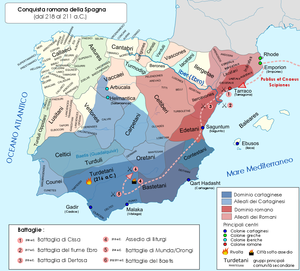Battle of the Upper Baetis
Before this defeat, the brothers had spent seven years (218–211 BC) campaigning against the Carthaginians in Hispania, thus limiting the resources available to Hannibal, who was simultaneously fighting the Romans in Italy.
After the defeat of Hasdrubal Barca in the Battle of Dertosa in the spring of 215 BC, the Romans had secured their bases north of the Ebro.
According to Livy, the Romans fought multiple battles against the Carthaginians south of the Ebro from 215–214 BC, at Iliturgi, Munda, and Orongi.
[2] Livy's chronology is confused and contradicted by Polybius, who explicitly states that the Scipio brothers did not venture south of the Ebro until 212 BC.
[2] The Scipios had persuaded Syphax, a Numidian king, to open hostilities against Carthage with an army that had been trained by Statorius, a Roman centurion, in 213 or 212 BC.
In 212 BC, the Scipio brothers captured Castulo, a major mining town and the home of Hannibal's wife Imilce.
[3] Leaving 2,000 soldiers in his camp under the legate Tiberius Fonteus, he marched out that night to launch an attack on the Iberians and, hopefully, evade Masinissa's cavalry.
Scipio marched throughout the night and caught Indibilis and his men by surprise in the early morning; and, with a numerical superiority, began to gain the upper hand in the ensuing action.
When Mago and Hasdrubal Gisco arrived with their combined armies, the Romans finally, after a grim struggle, broke and fled, leaving Publius Scipio and most of their comrades dead on the field.
Although unaware of Publius Scipio's fate, Gnaeus decided to withdraw towards northern Iberia after Mago and Hasdrubal Gisco arrived with their armies.
